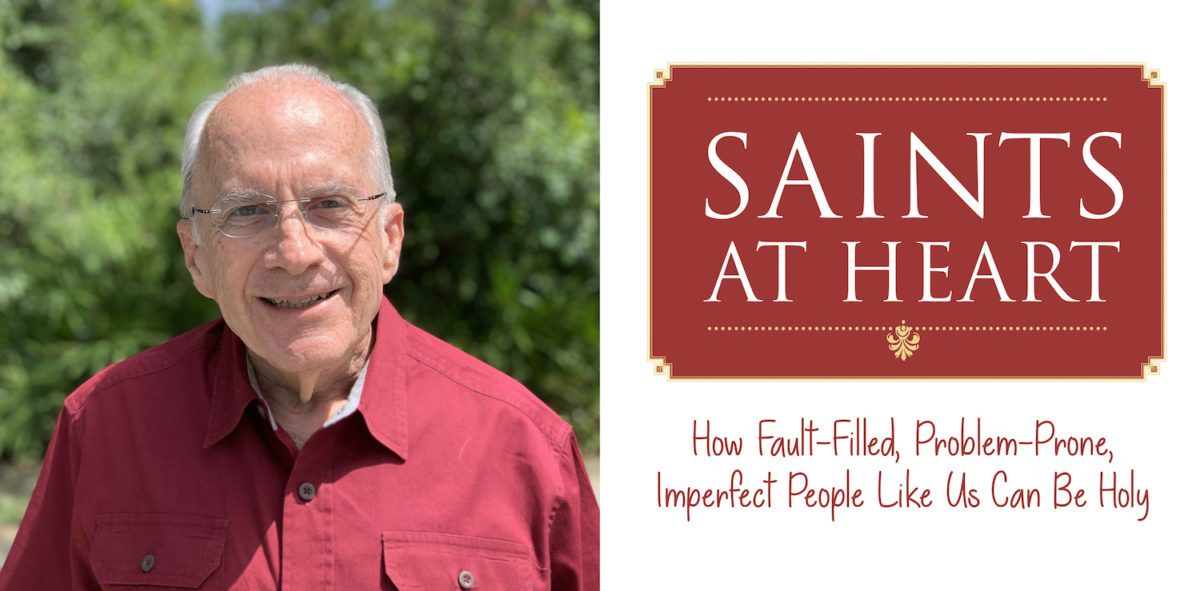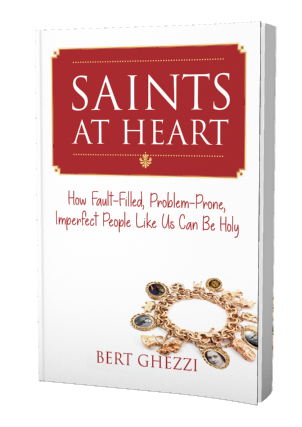For Christians, the goal of life is simple: to become a saint. That's it. Everything else is window dressing. To become a saint means falling in love with God and enjoying his friendship in this life and the next.
But how do we achieve that? One helpful way is to study the lives of men and woman who have already done it. In other words, look to those the Church has already recognized as fulfilling that goal. Just as aspiring basketball players study LeBron James and Steph Curry, both NBA champions and superstars, so Catholics should study St. Augustine, Mother Teresa, and St. Katherine Drexel.
Bert Ghezzi has been helping Catholics do that for years. His many books on the saints have opened up the lives of both famous and obscure saints, showing how they are not just models to admire from afar, but examples we can emulate and befriend, here and now.
His latest book is titled Saints at Heart: How Fault-Filled, Problem-Prone, Imperfect People Like Us Can Be Holy. It's an updated, revised version of a popular book he wrote years ago, and today Bert sits down with me to discuss the new edition.
BRANDON: Why did you write Saints at Heart?
BERT: Well, I believe that most people want to be good and to be happy. And I wanted to alert readers that goodness and happiness require something much more than a wish. We have to set a high goal if we want goodness and happiness. So I wrote Saints at Heart to persuade readers that we all must respond to God’s call to be holy as he is holy. I decided to tell the life stories of ten saints that would show the ways to respond to this universal call to holiness.
People who pick up the book will meet saints they are familiar with like Therese of Lisieux and Francis of Assisi. And they will encounter saints that they may have never heard of like Katharine Drexel and Pier-Giorgio Frassati.
BRANDON: Why did you choose the saints you included in the book?
BERT: The aim of the book was to illustrate the pathways to holiness and spiritual disciplines in the lives of saints that portrayed them clearly and with pizzazz. The chapters cover themes like loving God, loving others, conversion, prayer and Scripture study, social justice, and more. Many saints could fit the bill, but I allowed myself to choose ten of my favorite saints, each of whose experience emphasized a particular pathway or discipline.
For example, Francis of Assisi’s story shows that conversion to Christ is not a one-shot deal, but continues as a life-long process. And readers will learn from Katharine Drexel how to put God’s call to mission ahead of personal desires or dreams.
BRANDON: What does it mean for someone to be a saint?
BERT: Most people think they could never be a saint. They imagine that saints are in a class by themselves, that they arrived on the scene in a state of perfection. But God wants everyone to be a saint, ordinary people that he wants to live extraordinary lives. A saint is a person who lives their life wholly for God. To paraphrase one of Bishop Robert Barron’s constant themes, they have stopped living for lesser goods like pleasure, honor, wealth or power and now live for God alone.
People often wonder how they—sinners as they are—could become a saint. When St. Thomas Aquinas’s sister asked him that question, he said, “Will it!” We become saints by making a decision, by choosing to be holy. Many of the saints even tell us when they decided to be a saint. In Saints at Heart I note that Therese of Lisieux decided to become a saint at age 3 and Francis of Assisi at 19. I wanted the book to make it easy for readers to decide to become saints.
BRANDON: Dorothy Day is known as a social justice activist. Why did you select her for the chapter on prayer and Scripture?
BERT: Dorothy believed that prayer and reflection on Scripture were the engines that drove her work for social justice. As a writer and an advocate for the poor, Dorothy became convinced that prayer and Scripture sustained her and her service. She worshipped at daily Mass, prayed a layperson’s version of the liturgy of the hours, spent time in adoration of the Blessed Sacrament, and interceded for a long list of people. And she spent regular time studying and meditating on Scripture, the fruit of which found its way into her writing.
Now here’s why I chose her for this chapter. Dorothy was extremely busy with writing, speaking, administering Catholic Worker houses, personally feeding and tending the poor, raising her daughter, relating faithfully to church officials and more. I knew my readers would be very busy people. And I wanted to persuade them by Dorothy’s example that they must build prayer and Bible study into their daily routine. Since they saw her do it they would have no excuse not to.
BRANDON: Why does the Church give us saints?
BERT: The church has a threefold reason for naming saints. First, the saints are heroes of the faith. They lived ordinary lives in extraordinary ways and the church wants us to recognize them honor and imitate them. I want readers to be so attracted to saints in my book that they will aspire to become like them.
Second, the church encourages us to ask the saints to intercede for us. Of course, we should engage in direct conversation with God. But just as we ask our mother, uncle or good friend to pray for us, we should freely ask our friends in heaven to have a word with the Lord on our behalf.
Third, the church wants us to adopt saints as patrons, but it’s a practice we don’t take advantage of. A patron saint prays for us, accompanies us through the day, intercedes for us, protects and guides us, keeps us on purpose and joyful, and helps us stay close to God. That’s a big package of benefits. I hope that readers of Saints at Heart might select one of the saints that appeals to them as a patron.
BRANDON: In addition to describing saints’ strengths you also tell of their weaknesses. How do readers respond to that?
BERT: In Saints at Heart and my other books about saints I have always presented them as fully human beings who are basically good but who bear the marks of Original Sin. Like us, they had faults and weaknesses. And like us they sinned. I have often said that when we put St. Teresa of Avila up on a pedestal, she climbs right down and stands with us. My readers often tell me that they appreciate reckoning with the failures of the saints. When they see that saints have fallen along the way and were picked up by grace, they realize that, when they fall, God in his mercy will pick them up, too.
BRANDON: You obviously like all the saints you placed in the book. Do you have a favorite among them?
BERT: For over a quarter century I have studied and written about hundreds of saints. And I have warm feelings of affection for many of them. But of all the saints I revere, my very favorite is Bl. Pier-Giorgio Frassati.
I tell people that I love Pier-Giorgio because he was normal. A handsome young man with an engaging personality, he attracted a large group of friends. Pier-Giorgio was a dedicated mountain climber, the life of any party, and a practical joker. He was a thoughtful political activist who worked for the Christian Democrats and opposed the Fascists.
But a pure-hearted love of the Lord animated every aspect of Pier-Giorgio’s life. As a teen he daily served the poor in the back streets of Turin. He was devoted to the Virgin Mary and spent long hours in adoration of the Blessed Sacrament. When he took his friends mountain climbing, he arranged to have a priest come along to celebrate Mass at the peak.
Pier-Giorgio struggled in a dysfunctional family--his parents were bickering their way to divorce. The circumstances saddened him, but he was not gloomy and was always joyful. He died at age 24 of a virulent form of polio that he probably contracted from the poor he served.
Join me in praying for Pier-Giorgio’s canonization. Our youth and elderly Catholics like me want him recognized as a patron.


